A Brief History of Angling Literature Produced by the Flyfisher’s Club of Oregon
Mark Metzdorff, MD
President 2001-02
Editor, The Flyline, 2000-10
At the Club’s December 2021 meeting, I gave a brief presentation on the significant history of angling literature produced by the Flyfisher’s Club of Oregon (FCO) over its 60-year span. This talk was inspired by, and coincided with, the publication of the book celebrating the Club’s anniversary: The Creel: 60th Anniversary Edition. The newsletter Editor and Club leadership requested that I put the talk to writing for the benefit of those who could not attend the meeting. Thus, this article will recapitulate and expand on that address, and hopefully will inspire Club members to seek out and appreciate the literature which has been produced by their Club over the years. A great place to start would be the recent anthology!
The Creel
From the very beginning, Club founders recognized the importance of angling literature to the enjoyment of the sport. At the Club’s initial meeting in April of 1961, a Club Charter was approved which listed the “Origins and Purposes” of the Club including the clause “…To publish semi-annually a publication to be known as The Creel recording the angling accomplishments, adventures and speculations of the members and other fly fishing devotees…” Led by the Club’s first President Vernon S. “Pete” Hidy, a committee was formed and by December the club’s first Creel was published (Figure 1).
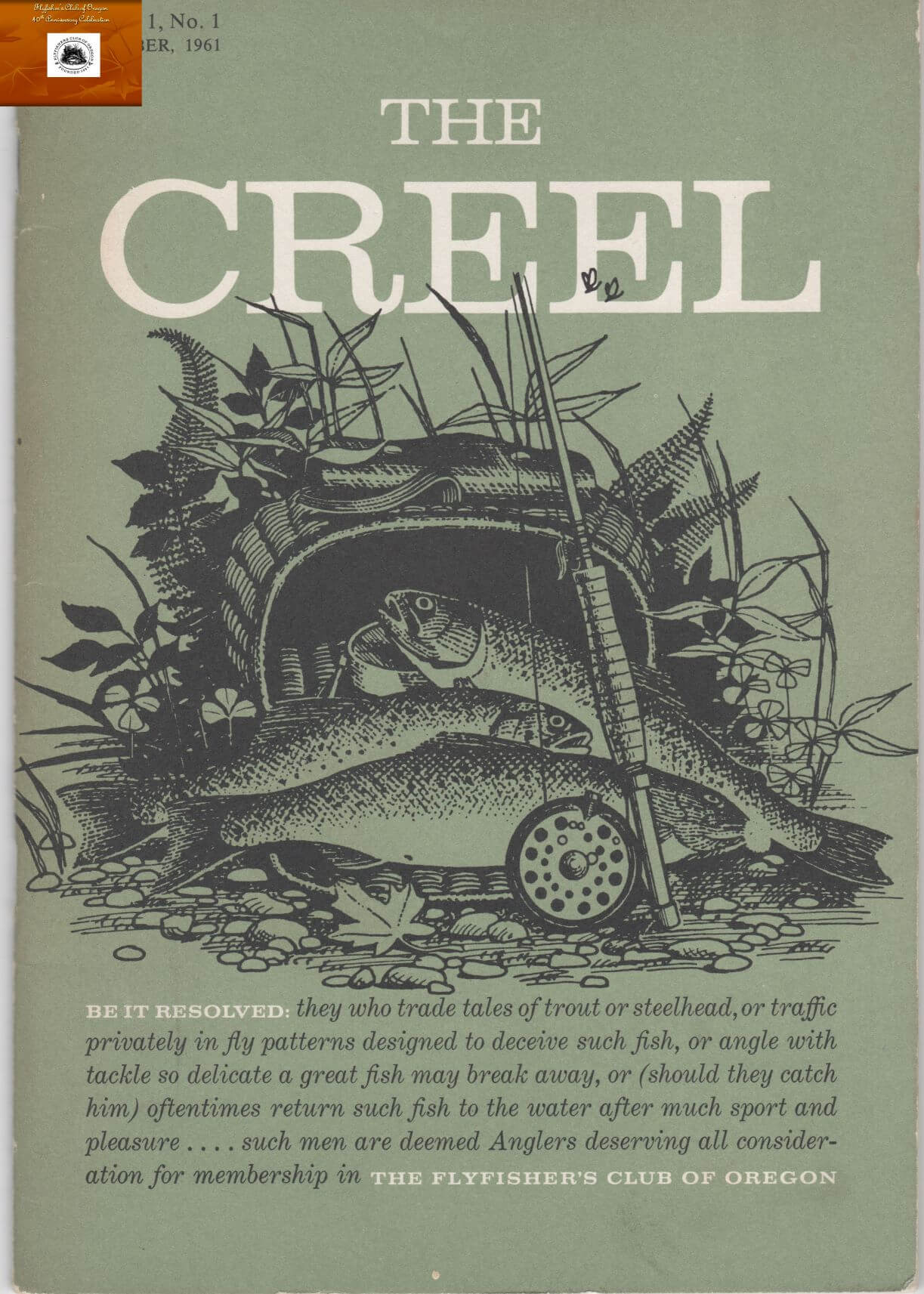
Figure 1. 1961 Creel
The Creel Committee members were Co-Editors Robert O. Beatty, Lenox Dick, Hidy, Fred Locke and Robert Wethern; the Art Director was Douglas Lynch; and printing was arranged by member and commercial printer Fred O. Hallwyler. Hidy was already an established angling writer, having produced The Art of Tying the Wet Fly with James Leisenring, and contributed articles to Sports Illustrated. Dick and Wethern went on to serve as Presidents of the FCO. Lynch was a well-known graphic designer who, among many other things, designed the Portland city flag, and the original FCO logo, as well as many illustrations in The Creel. An important non-member (initially) of the Club who contributed greatly to Club publications over many years was Tom McAllister, an outdoor writer for The Oregon Journal and The Oregonian newspapers, and who wrote the first article in Vol. 1, No. 1 of The Creel (Figure 2).

Figure 2. Clockwise from upper left: Beatty, Dick, Hidy, Locke, Wethern, Lynch, Hallwyler, McAllister
The Creel Committee conceived the publication as a semi-annual journal in 6 X 9″pamphlet format with a color cover and 32 black and white pages. Per the Club Charter, its scope included stories, Club events, how-to’s, book reviews and more. In all, 21 issues were produced between December 1961 and 1982. The Creel Committee varied from issue to issue, but Hidy, Wethern, Dick, McAllister and others were frequent members, and Lynch was Art Director of all issues. A final homage to the original publication was produced to celebrate the club’s 30th anniversary in 1991. Wethern and Lynch were on its committee; and while still in the familiar pamphlet format, it was printed in a larger size and had 48 interior pages.
Of course many of the articles in The Creel were the work of Club members, but not a few featured national and international luminaries of fly fishing, including Canadian author Roderick Haig-Brown, Oregon Poet Laureate Ben Hur Lampman, noted anglers Ralph Wahl, Lee Richardson and Syd Glasso, as well as author Steve Raymond, CBS News correspondent Eric Severeid, and Parisian hotelier Charles Ritz, among many others.

Figure 3. Hidy and Ritz pictured.
Through promotion by Club members, The Creel quickly gained national and international acclaim. In 1962 the esteemed editor of the Bulletin of the Angler’s Club of New York, Alfred W. Miller (whose nom de plume was Sparse Grey Hackle, Figure 4) wrote to Hidy, “The Creel is as good a job of producing a non-commercial publication as I recall ever seeing.”

Figure 4. Alfred W. Miller, nom de plume Sparse Grey Hackle.
His praise may have been a little self-serving, since he and Hidy had corresponded, and Miller had provided advice, during the development of the publication. Still, others concurred in his opinion, and the work was done by the Creel Committee. Also in 1962, FCO member Fred Hallwyler exchanged a copy of the first issue of The Creel for a history of The Flyfishers’ Club (London) during a visit to that hallowed institution. In 1974, Arnold Gingrich, co-founder and editor of Esquire magazine, in his book The Fishing in Print (Figure 5), described The Creel as “…the beautiful and distinctive organ of The Flyfisher’s Club of Oregon.”

Figure 5. Author Arthur Gingrich extolled the beauty and distinction of the Creel.
And, in 1980, after the delivery of a complete set of Creels to the Museum of American Fly Fishing in Manchester, Vermont, the spring issue of the museum’s journal The American Flyfisher (Figure 6), focused on Western angling, carried a glowing tribute concluding, “The accomplishments of The Creel over the past twenty years, both in literature and in history, are magnificent. Western angling history is in good hands.” Though the review was unattributed, I recently learned that the author was Paul Schullery, the Executive Director of the Museum and editor of the Journal at that time; an accomplished author in his own right, and a good friend of Bob Wethern and Steve Raymond.

Figure 6.
The Newsletter
A Club newsletter was a feature of the FCO from the beginning, but early on as a literary source was limited to only the briefest of anecdotes, and it didn’t change much in the first thirty years of the FCO’s existence. A succession of hardworking volunteers edited, addressed, stamped and mailed the newsletter every month. While possibly not an exhaustive list of editors, those with notable tenures in the first three decades included Pete Jenkins, Phil Trautmann and Frank Rodriguez (Figure 7).

Figure 7. Examples of FCO Newsletters and their editors during the first 3 decades.
Later, Dick Williamson and Alex Rattray evolved the style of the newsletter, with Alex affixing the title which holds to this day: The Flyline. Williamson returned for an encore term and, not to be outdone by Rattray, again took the newsletter style to another level (Figure 8).

Figure 8. The Flyline emerged in the early 1990’s.
Up to and including this iteration, all work was done by mimeograph or photocopying, with literal cutting-and-pasting, prior to final duplication and distribution. I took over as editor of the newsletter while also President in 2001, and began using an electronic digital process for constructing the paper copies which were still mailed out every month, and continued as editor after moving to Denver in 2007. In 2010, Club stalwart Lisa Hansen succeeded me and truly shepherded the newsletter into the 21st century by converting to a web-based format (Figure 9) that saved the club more than $2000/year in printing and mailing costs.

Figure 9. Flyline evolution from digitally produced hard copy to web-based communication.
Some members felt a loss of a revered tradition that they enjoyed receiving in the mail each month, however the financial savings accrued to the ongoing good works of the Club’s Flyfisher Foundation.
After the cessation of the original Creel in 1982, the newsletter became the de facto outlet for the literary efforts of Club members and others, and continues to be so to this day. Fortunately, members continue to submit original works, tributes to members who’ve “crossed the river” continue to be published, and Club history is recorded. As editor for 10 years, I was fortunate to have Bob Wethern as an enthusiastic contributor, both in his original works, and as a broker of others’ writings. He frequently referred to his “spider web of connections,” which kept me in constant good supply of material for the monthly publication. He passed away in 2008, and I, and the Club, miss him greatly.
Literary Members and Speakers
The Club has counted as members many notable writers, including but perhaps not limited to those listed in Figure 10.

Figure 10.
It also periodically bestows the “Vernon S. ‘Pete’ Hidy Award” (Figure 11) for individuals deemed to have made significant contributions to the literature of angling; among those are club members Dave Hughes, Jim Schollmeyer and Ted Leeson.

Figure 11.
Apart from authors featured in Club publications, many literary notables have been speakers at the Club’s monthly meetings, often at the annual “Couple’s Night” as was Ernest Schwiebert in 2004, seen in Figure 12 with fellow author and Club member Dan Callaghan.

Figure 12. The late FCO member and author, Dan Callaghan, with well-known author, Ernest Schwiebert at December 2004 meeting.
The Club Foundation and Library
The Flyfisher Foundation, established by the Club in 1973, was created to be a steward to the Club’s assets, both monetary and other. A major part of these assets was the Club’s library, which accrued hundreds of volumes beginning with a donation of more than 600 titles by member Thomas C. Young in 1973. Along with the library, art works and memorabilia, the Foundation also oversaw a cash corpus, which was directed at a hoped-for acquisition of a clubhouse property. By the year 2000 it was apparent that this goal would not likely be achieved, and the Foundation elected to convert to a more community-focused approach, by liquidating some assets, and conveying the bulk of the library to the Multnomah County Library. The most rare and valuable books are now located in the Wilson Room as the “C. Edwin Francis Collection of The Flyfisher’s Club of Oregon,” and are available by appointment for public viewing or scholarship. Francis was the Club’s first and perhaps only librarian. Other books were delegated to the library’s general circulation, each with a book plate indicating their origin from the Club (Figure 13).

Figure 13. FCO bookplate.
The Foundation provides the Wilson Room with $5000/year for maintenance and further acquisitions, and for housing the Club’s archives.
Decadal Creels
Before 2021, four of the five Club decadal anniversaries were in part marked by the publication of special versions of The Creel (Figure 14).

Figure 14. Decadal Creels.
The first two, in 1971 and 1991, were in the traditional pamphlet formula. The second two, hardcover books published by FCO member Frank Amato’s company, were largely the work of Bob Wethern, who conceived of a “Rivers of Oregon” series. His books on the McKenzie and North Umpqua rivers captured precious history on these storied waterways, and were funded by The Flyfisher Foundation. They were released in connection with the Club’s 40th and 50th anniversaries. The remainder of Bob’s vision, to include books on the South Umpqua, Deschutes, and others, was interrupted by his death, and awaits an enterprising Club member to pick up the baton.
The Creel: 60th Anniversary Edition was conceived around 2019 with the next decadal anniversary in sight. The idea of an anthology celebrating the “Best of” FCO literature had been around since at least the early 1980s after the original Creel ceased publication. As the 60th anniversary approached, several group discussions resulted in a commitment to the project. John Pyrch was an early driving force in the effort, and funding was obtained through a generous grant from The Flyfisher Foundation. A Creel Committee of just seven FCO members was formed (Figure 15).

Figure 15. The 60th Anniversary Creel Committee, from top, left to right, Jim Hillas, Mark Metzdorff, Lisa Hansen, Rich Fitterer, Paul Franklin, John Pyrch, and Robert Sheley.
Nearly two years of work ensued, greatly hampered of course by pandemic restrictions. A special thanks goes to a great friend of the FCO, Jim Carmin, the Wilson Special Collections Librarian of the Multnomah County Library, for help with access to FCO archives remotely during the library’s closure. The resultant book was self-published with the aid of Gorham Printing of Centralia, Washington, in a limited print run to allow each FCO member one copy with some extras for purchase or donation. So far, the book has been very well-received, although a significant number of members have yet to pick up their copy (Figure 16).
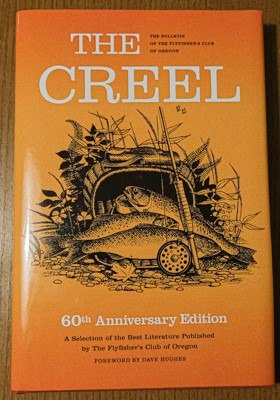
Figure 16. The Creel: 60th Anniversary Edition.
Context: Sixty Years of Literary Heritage
From Dame Juliana Berners to Dec Hogan, literature has been a constant and important feature of the pursuit of fish with the fly. The literary efforts of the Flyfisher’s Club of Oregon have received support and recognition, nationally and internationally, for much of its sixty years. It is a heritage perhaps under-appreciated by many Club members who have lacked exposure to this history, which is a significant and unique aspect of the Club.
Along with the Club Charter discussed above, the first statement in the list of Purposes for The Flyfisher Foundation is:
- “To preserve and perpetuate the traditions, history, art and literature of fly fishing”
By producing the current anniversary anthology, the Creel Committee, as an extension of the Club and Foundation, hopes to inspire the members of the Flyfisher’s Club of Oregon to learn about, celebrate and actively participate, in the Club’s storied literary tradition. What can you do?
- Pick up and read your copy of the anthology! Call today! Operators are standing by!
- Contribute your stories, poems, photos, fly patterns, book reviews or other literary efforts to The Flyline
- Support publishers and writers who enrich our sport
- Buy books by angling writers
- Subscribe to magazines that feature angling writers and literature
- Buy copies of the 60th Anniversary Creel to give to friends and relatives
- Encourage like-minded people to join our Club
- VOLUNTEER! The Club needs fresh, inspired leaders and workers who can embrace its heritage and carry it forward
I will close with a personal perspective on The Flyfisher’s Club of Oregon. The Club has given me immeasurable pleasures over my thirty-plus years of membership: Friendships, angling experiences both familiar and exotic, the acquaintance and knowledge of many world-class practitioners of our sport, a chance to serve my Club and community, and yes, an appreciation for the literature of angling.
However, my sense as a senior member of this Club is that we are at a tipping point. The number of persons who are willing to do the volunteer work necessary to keep the Club functioning, let alone thriving, is diminishing. Those who have done and continue to do the work are to be congratulated, but they are suffering from burnout. The pandemic has been a factor in the Club’s recent course, but the decline I perceive started before that. For some years now we have had unfilled positions on our boards, and finding people to step up to leadership positions has been difficult.
The heritage handed down to us by the women and men featured in the Club’s writings is one of the attributes that defines our Club, and separates it from others which lack our foundational aspirations. It would be a shame to lose sight of this, to lose the things that make our Club unique, and perhaps to lose our Club altogether. It is my hope as we emerge from the pandemic and begin our hoped-for next 60 years, that Club members will step up and honor the Club’s heritage by serving with enthusiasm and diligence in positions of leadership and responsibility. It is an opportunity that will enrich your appreciation of angling with the fly, and enhance your sense of belonging to a hallowed, respected institution that has stood above others for 60 years (Figure 17).

Figure 17. Original FCO logo.
The Creel, 60th Anniversary Edition: More Reviews and Connections
As previously mentioned, after its unveiling at the 60th Anniversary meeting in December, the latest Creel has been well-received by FCO members and others. Paul Schullery, noted author, former executive Director of the American Museum of Fly Fishing, and former editor of its journal The American Fly Fisher, sent a lovely note (Figure 1) after receiving his copy, which was sent on the recommendation of author and FCO friend Steve Raymond. I encouraged Paul to write a review for the AMFF journal, but to take it easy on we amateurs who are represented in the anthology.
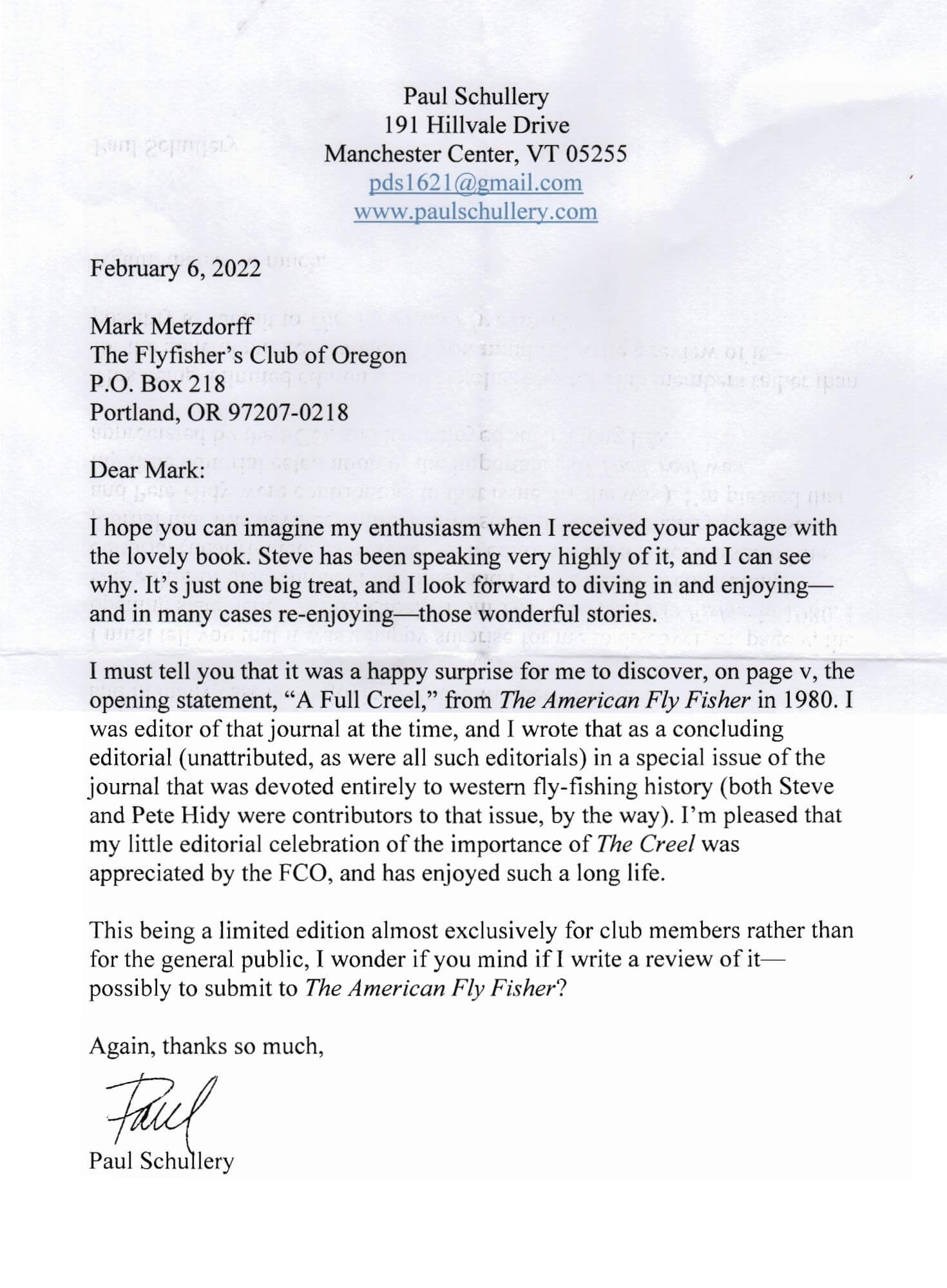
Figure 1. Paul Schullery letter.Recently, the current executive director of the AMFF, Sarah Foster, also sent a nice note acknowledging our donation of a copy of the 60th anniversary book, as well as the two issues of The Creel published after 1980 which their collection lacked (Figure 2).
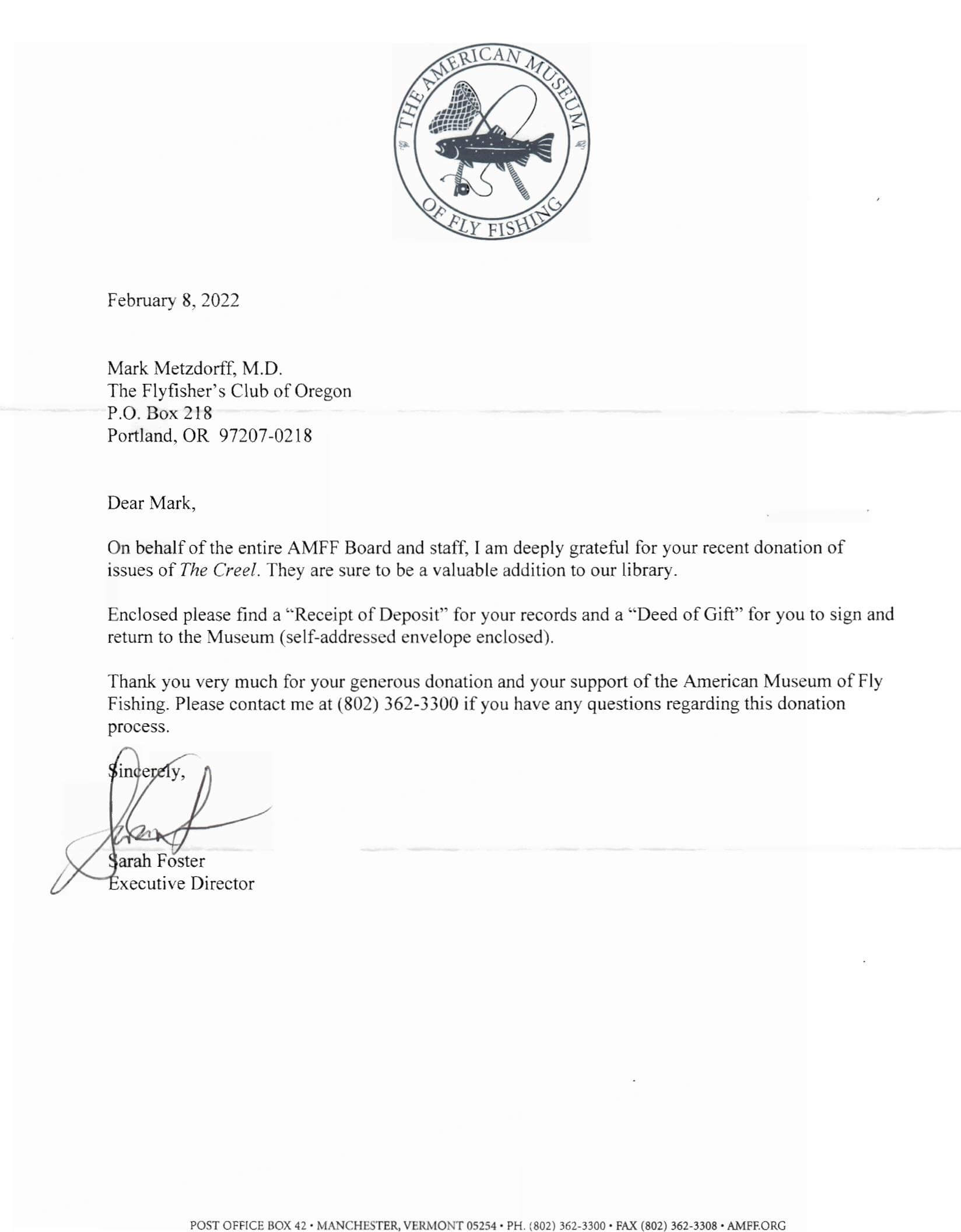
Figure 2. AMFF letter.A “complete” set of the original paper Creels was conveyed to them by the club in 1980, but two additional issues were published in 1982 and 1991. Bob Wethern had also sent them copies of his “Rivers of Oregon” series books (the McKenzie and North Umpqua Creels, published in association with the FCO’s 40th and 50th anniversaries, respectively). Now with the addition of the two missing paper Creels and the new book, their collection is up to date.
Vermont member Barry Mayer sent a brief email in February:
- “The Creel came a few days ago. I want you to know how very much I appreciate the effort you made to put it together. And more specifically how honored I am to have been included among some really accomplished and highly regarded authors.”
And just today (March 2), I received an acknowledgment from the Librarian of The Flyfishers’ Club (of London):
“Dear Mark,
I am writing in my capacity as Librarian of The Flyfishers’ Club to thank you for the copy of your club’s 60th Anniversary anthology. It is always interesting for our members to read about, and keep in contact with, other angling institutions, and particularly kind of you to think of us when the production is limited.
I do hope that you will be able to travel to the UK before long, and that you will visit us when you do. Please let us know in advance so that we can arrange to show you the Club and its Library.
With thanks and kind regards,
Stephen Hodges”
Readers of the old Creels will know that correspondence between our Club and the London Flyfishers’ began when charter member Fred Hallwyler gifted copies of the first two issues of our journal to the London club during a visit in 1962. Members of the London club in turn gave Fred a copy of their club history. This prompted me to see if the volume Fred received is still in our collection, and after a note to Jim Carmin at the Wilson Room of the Multnomah County Library where our collection is housed, Jim sent me a photo of the very book (Figure 3), along with another anthology published by the London club in 1984.
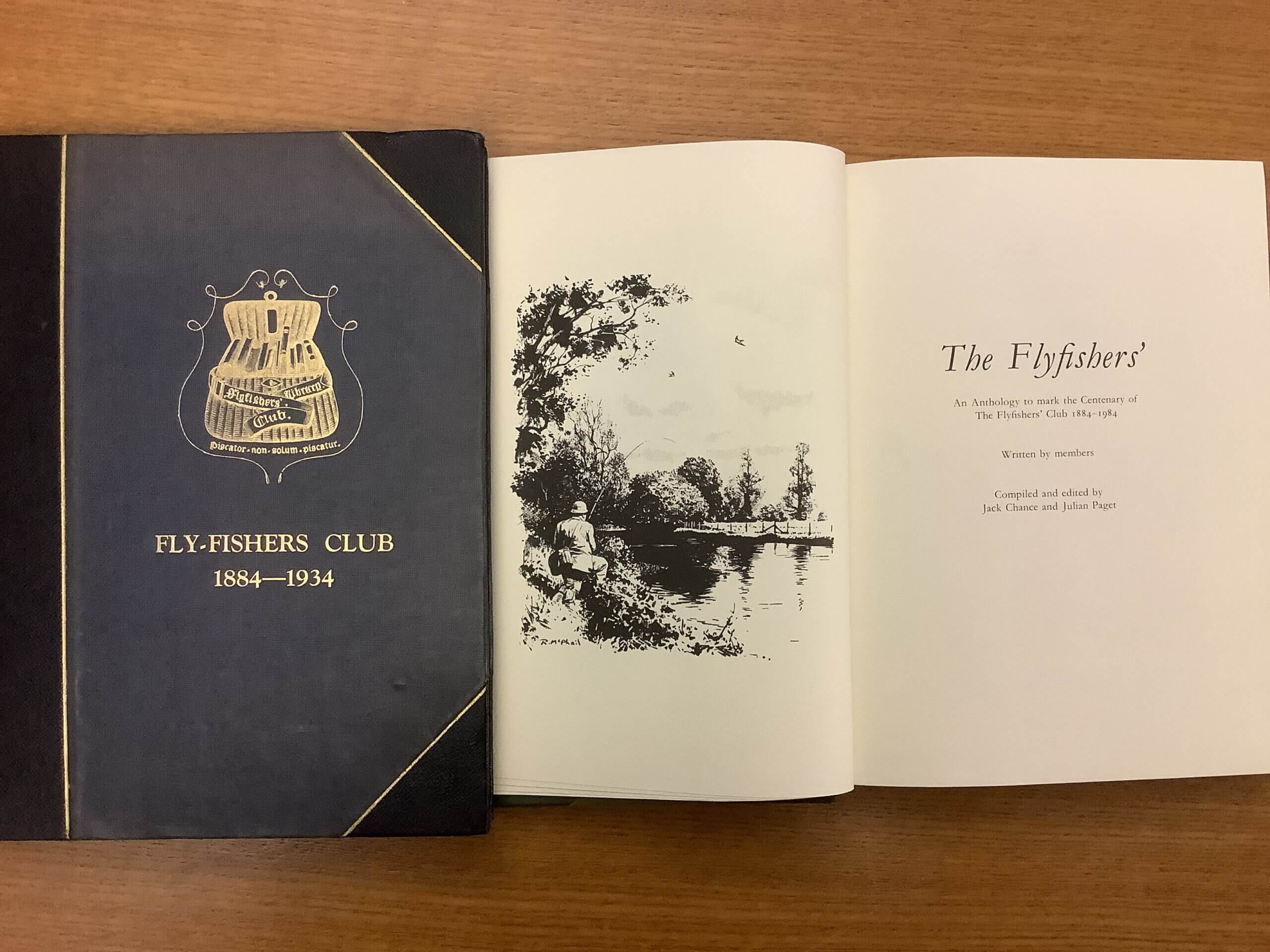
Figure 3. Flyfisher’s Club of London books in the Wilson Room of the Multnomah County Library.I can’t wait to see these two volumes; I replied to Mr. Hodges that we seem to have gotten the better of the bargain, trading a couple of humble contemporary paper pamphlets for their 1934 hardbound history! Apparently some club member must have visited the London club around or after 1984, or perhaps acquired the second book somehow and donated it to the club. I am sure that a visit to The Flyfishers’ Club could be arranged for any member of our club who finds themselves in London in the future.
These are the kind of benefits one can get from belonging to a Club with history, and a respect for history and literature…
Dr. Mark Metzdorff

